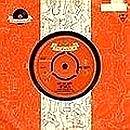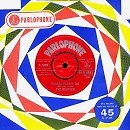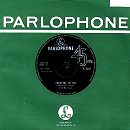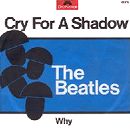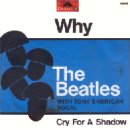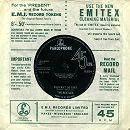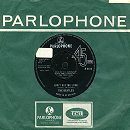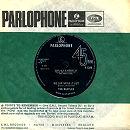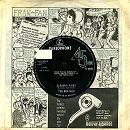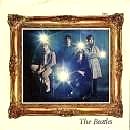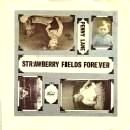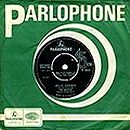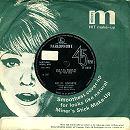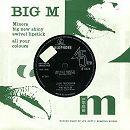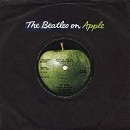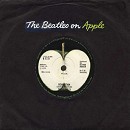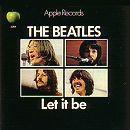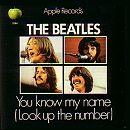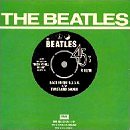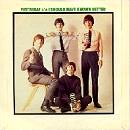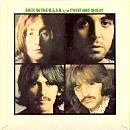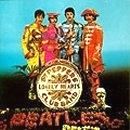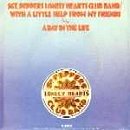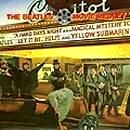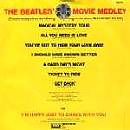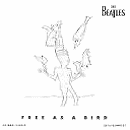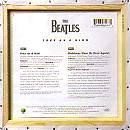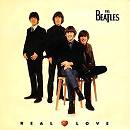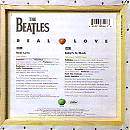 |
|||||||||||||||||||||||||||||||||||||||||||||||||||||
Side A: My Bonnie
|
|||||||||||||||||||||||||||||||||||||||||||||||||||||
|
(front) |
Side A: Love Me Do
Side B: P.S. I Love You
(Parlophone 45-R 4949 MONO)
Released 5th October 1962
Ringo had only been a Beatle for a couple of weeks when they recorded 'Love Me Do', and George Martin thought he was a bit ring-rusty (if you pardon the pun) so he hired a session musician called Andy White to replace him, and Ringo was left banging the tambourine. The single that eventually went out was an early version (with Ringo on the drums) but later pressings had Andy White on the drums and Ringo playing the tambourine. You can tell the difference by looking at the colour of the label - Ringo's version is red, and Andy White's is black. (Note: The Please Please Me LP and the Beatles' Hits EP also used the Andy White version.)
Brian Epstein supposedly bought up 10,000 copies for his chain of record shops - because that's how many you needed to get in the Top 20. But some people think it was nowhere near that figure. Peter Brown explained: “Brian bought more copies than he normally would, but if he was saying that his band was going to be bigger than Elvis, then he had to put his money where his mouth was.” Unfortunately, he then made the mistake of letting EMI's own publishing company promote it, who did next to nothing to plug it, so he took his business elsewhere for their next release.
[N.B.: In 1976 Paul's own company MPL Communications bought the copyright back from EMI, so these are the only two songs in the whole of the Beatles catalogue that are still owned by a Beatle!]
Highest chart position: Disc Weekly) #24;
Melody Maker) #21; NME) #27; Record Mirror) #17; Record Retailer) #17
Weeks in chart: 18 (from 13th October 1962)
|
(front) |
Side A: Please Please Me
Side B: Ask Me Why
(Parlophone 45-R 4983 MONO)
Released 11th January 1963
Brian was unhappy about how little Ardmore & Beechwood did to plug 'Love Me Do', so he found another publisher for this release. His first idea was to use an American company, but George Martin suggested that he try-out a few British ones instead - one of them being Dick James Music. So Brian set up a couple of appointments and went round early next morning. So the story goes, the first company kept him waiting past the appointed time so he packed his bags and left. But Dick James turned up bright and breezy and put the record on the player. Brian asked him what he could do for The Beatles. So he phoned up the producer of ITV's Thank Your Lucky Stars and piped the single down the phone, and secured them a spot on national telly there and then. And Epstein, who couldn't believe his fucking luck, promptly gave James the deal.
Although it hit the top-spot in five separate charts, it failed to reach the summit in Record Retailer - which is generally accepted as being the benchmark (it was kept off the top by Frank Ifield’s' 'Wayward Wind'). So 'Please Please Me' is usually classed as a No.2.
Highest chart position: BBC) #1; Disc Weekly)
#1; Melody Maker) #1; NME) #1; Record Mirror) #1; Record Retailer) #2
Weeks in chart: 18 (from 19th January 1963)
|
(front) |
Side A: From Me To You
Side B: Thank You Girl
(Parlophone R 5015 MONO)
Released 11th April 1963
In an amazing run of Beatles-related numbers, 'From Me To You' knocked 'How Do You Do It' off the top - the song they turned down in favour of 'Love Me Do'. (Gerry and the Pacemakers returned the favour two months later by knocking them off with 'I Like It'.) But the song that immediately replaced them was another Lennon/McCartney number, Billy J. Kramer's version of 'Do You Want To Know A Secret', the B-side of which was another John song - 'I'll Be On Me Way'.
This was the first Beatles single to reach number one in every published chart, and started a string of eleven consecutive number ones.
Highest chart position: BBC) #1; Disc Weekly)
#1; Melody Maker) #1; NME) #1; Record Retailer) #1
It stayed top for 7 weeks (from 4th May 1963)
Weeks in chart: 21 (from 20th April 1963)
|
(front) |
Side A: She Loves You
Side B: I'll Get You
(Parlophone R 5055 MONO)
Released 23rd August 1963
This one has a hatful of records: It was Britain's first-ever million-seller, and the biggest-selling single of 1963 (and remains their highest-ever seller in the UK); it charted for longer than any other British single (and stayed in the Top 40 for an incredible 31 weeks), and was the highest-selling single for 14 years (until Wing's hit 'Mull Of Kintyre'). It even managed to reach number one twice. It spent four weeks at the top to start with, before dropping back into the top three to let someone else have a go, and then it stormed back to the top six weeks later. And just to rub it in a bit more, it then yo-yoed back into the charts eight months later, peaking at number 42!
Despite all the fuss in Britain, Capitol were still unmoved by Beatlemania, and steadfastly refused to take them up. Even the normally mild-mannered George Martin was starting to get pissed off: “I said, for God's sake, do something about this. These boys are breaking it, and they're going to be fantastic throughout the world. So for heaven's sake latch onto them.”
Highest chart position: BBC) #1; Disc Weekly)
#1; Melody Maker) #1; NME) #1; Record Retailer) #1
It stayed top for a combined total of 6 weeks (four weeks from 14th
September, and two weeks from 30th November 1963)
Weeks in chart: 33 (thirty-one weeks from 31st August 1963, and two
weeks from 11th April 1964)
UK sales figures: after 3 months - 1¼ million; to date - 1½ million
|
(front) |
Side A: I Want To Hold Your Hand
Side B: This Boy
(Parlophone R 5084 MONO)
Released 29th November 1963
When 'I Want To Hold Your Hand' replaced 'She Loves You' at the top of the charts, the Beatles became the first band in British history to knock themselves off the top spot. It was also the first single to have an advance order of a million copies, and it was the second biggest-seller of 1963 (behind 'She Loves You'). And as if all that wasn't enough, they also made history by simultaneously holding onto the top two spots in both the albums and the singles chart!
It was eventually dethroned by the Dave Clark Five's 'Glad All Over', who hailed from London. Fleet Street immediately lauded them as the “latest sensation” - grateful for a little local success for a change. And even John started getting worried: “We couldn't help it,” he said. “Everyone was telling us Dave Clark is coming, you've had it now. He worried us, the same way that we worried in Liverpool when Gerry and the Pacemakers beat us in the Mersey Beat poll.” But he needn't have worried - you can only go so far with a name like Dave.
Highest chart position: BBC) #1; Disc Weekly)
#1; Melody Maker) #1; NME) #1; Record Retailer) #1
It stayed top for 5 weeks (from 14th December 1963)
Weeks in chart: 22 (twenty-one weeks from 7th December 1963, and one
week from 16th May 1964)
UK sales figures: after 2 months - 1½ million
|
front |
Germany invades England...
In January 1964 a brand-new single appeared in the
shops, Sweet Georgia Brown b/w Nobody's Child. Although
many discographies list this as a British release, it was never
actually sold as such. The singles were shipped in from the
Fatherland, and contained songs from the Tony Sheridan set.
|
(front) |
(back) |
Side A: Cry For A Shadow
Side B: Why [With
Tony Sheridan]
(Polydor NH 52275 MONO)
Released 28th February 1964
German Polydor originally planned to release 'Why' as a Tony Sheridan single in March '62, as a follow-up to the 'My Bonnie' single. But they chose to go with Ich Lieb' Dich So b/w Der Kiss-Me Song instead - another couple of Tony Sheridan songs that did not involve the Beatles. Things soon changed in the winter of '63 however, when Beatlemania started sweeping the UK. And because the B-side was a genuine Beatles track (ableit, just an instrumental) 'Why' was demoted to the flip.
Highest chart position: Record Retailer) didn't enter
|
(front) |
(back) |
Side A: Can't Buy Me Love
Side B: You Can't Do That
(Parlophone R 5114 MONO)
Released 20th March 1964
This had advance orders of over a million, and was knocked off the top by Peter & Gordon's 'World Without Love', which was written by Paul.
Highest chart position: BBC) #1; Disc Weekly)
#1; Melody Maker) #1; NME) #1; Record Retailer) #1
It stayed top for 3 weeks (from 4th April 1964)
Weeks in chart: 15 (fourteen weeks from 28th March, and one week from
11th July 1964)
UK sales figures: 1½ million
|
(front) |
Side A: Ain't She Sweet
Side B: If You Love Me, Baby [With
Tony Sheridan]
(Polydor NH 52317 MONO)
Released 29th May 1964
This was just a couple of songs from their Hamburg set. 'If You Love Me, Baby' was the alternative name for 'Take Out Some Insurance On Me, Baby'.
Highest chart position: Melody Maker) #24;
NME) #29; Record Retailer) #29
Weeks in chart: 6 (from 13th June 1964)
|
(front) |
Side A: A Hard Day's Night
Side B: Things We Said Today
(Parlophone R 5160 MONO)
Released 10th July 1964
When this replaced the Rolling Stones 'It's All Over Now' at number one, the Beatles made a little bit of history by becoming the first band to simultaneously hold onto the top spots in both the album and the singles chart in both the UK and the States. Simon and Garfunkel were the next to do it, with Bridge Over Troubled Water in 1970.
Highest chart position: BBC) #1; Disc Weekly)
#1; Melody Maker) #1; NME) #1; Record Retailer) #1
It stayed top for 3 weeks (from 25th July 1964)
Weeks in chart: 13 (from 18th July 1964)
|
(front) |
Side A: I Feel Fine
Side B: She's A Woman
(Parlophone R 5200 MONO)
Released 27th November 1964
This knocked the Rolling Stones 'Little Red Rooster' off the top.
Highest chart position: BBC) #1; Disc Weekly)
#1; Melody Maker) #1; NME) #1; Record Retailer) #1
It stayed top for 5 weeks (from 12th December 1964)
Weeks in chart: 13 (from 5th December 1964)
UK sales figures: after 2 weeks - over 1 million
|
front |
Sneaky dealers import a new single...
A brand new single If I Fell b/w Tell Me Why appeared in the shops in January '65. It was never an official release (because it was made for export purposes back in October), but some sneaky dealers started shipping them into Britain, so EMI printed off a few copies to sell in the stores.
Despite it's exclusive nature, it failed to
dent the charts.
|
(front) |
Side A: Ticket To Ride
Side B: Yes It Is
(Parlophone R 5265 MONO)
Released 9th April 1965
Highest chart position: BBC) #1; Disc Weekly)
#1; Melody Maker) #1; NME) #1; Record Retailer) #1
It stayed top for 3 weeks (from 24th April 1965)
Weeks in chart: 12 (from 17th April 1965)
|
(front) |
Side A: Help!
Side B: I'm Down
(Parlophone R 5305 MONO)
Released 23rd July 1965
Highest chart position: BBC) #1; Disc Weekly)
#1; Melody Maker) #1; NME) #1; Record Retailer) #1
It stayed top for 3 weeks (from 7th August 1965)
Weeks in chart: 14 (from 31st July 1965)
UK sales figures: 900,000
|
(front) |
We Can Work It Out
Day Tripper
(Parlophone R 5389 MONO)
Released 3rd December 1965
DOUBLE A-SIDE
They originally chose John's 'Day Tripper' as the sole A-side, but then Paul came up with 'We Can Work It Out', so they had a row about whose song was more worthy. EMI actually announced that 'We Can Work It Out' would be the A-side on the 15th November. But two days later John released a statement saying that 'Day Tripper' would be! In the end they decided to release it as the world's first-ever double A-side. And it was a bit of a return to form, because it was their fastest-selling single since 'Can't Buy Me Love'.
It also won the Ivor Novello award for being the 'Biggest Selling Single of 1965'.
Highest chart position: BBC) #1; Disc Weekly)
#1; Melody Maker) #1; NME) #1; Record Retailer) #1
It stayed top for 5 weeks (from 18th December 1965)
Weeks in chart: 12 (from 11th December 1965)
UK sales figures: over 1 million
|
(front) |
Side A: Paperback Writer
Side B: Rain
(Parlophone R 5452 MONO)
Released 10th June 1966
Although this was widely regarded as a disappointment when it first came out, it's hard to dismiss when it's got 'Rain' on the flip. It knocked Frank Sinatra's 'Strangers In The Night' off the top of the charts, and was displaced by the Kinks' classic 'Sunny Afternoon'.
They also used the famous 'Butcher' photos to promote it. But when they tried using the same photos in the US it caused a fucking uproar! It kicked off the worst couple of months in Beatles history, because they were just about to get mobbed in the Philippines... get barracked in the States over John's 'Jesus comment'... and were on the verge of quitting touring for good.
Highest chart position: BBC) #1; Disc Weekly)
#1; Melody Maker) #1; NME) #1; Record Retailer) #1
It stayed top for 2 weeks (from 25th June 1966)
Weeks in chart: 11 (from 18th June 1966)
|
(front) |
(back) |
Yellow Submarine
Eleanor Rigby
(Parlophone R 5493 MONO)
Released 5th August 1966
DOUBLE A-SIDE
This knocked The Troggs off the top, and won the Ivor Novello award for being the 'A-Side Of The Record Issued In 1966 Which Achieved The Highest Certified British Sales In The Period 1st January 1966 To 31st December 1966'.
Because they never made a promo for it, when Top Of The Pops came to show it on the telly they used some old footage of a woman swimming, and a priest walking around a cemetery!
Highest chart position: BBC) #1; Disc Weekly)
#1; Melody Maker) #1; NME) #1; Record Retailer) #1
It stayed top for 4 weeks (from 20th August 1966)
Weeks in chart: 13 (from 13th August 1966)
|
(front) |
(back) |
Strawberry Fields Forever
Penny Lane
(Parlophone R 5570 MONO)
Released 17th February 1967
DOUBLE A-SIDE
The greatest single ever. But it was kept off the top-spot by Engelbert fucking Humperdinck! Which brought to an end their run of twelve consecutive number ones. (Unlucky 13, perhaps?) They were originally going to put them on the Pepper LP, but they were taking so long over it that Capitol started getting itchy feet. George Martin gave them these to keep them sweet - something which he later said was “the biggest mistake of my professional life.” (Because just imagine how good Sgt. Peppers would have been with them on it!) “They wanted a single,” he said. “And Brian was genuinely frightened that they were slipping. He wanted another single out that was going to be a blockbuster, so I put together 'Strawberry Fields Forever' and 'Penny Lane' and said to him, 'If this isn't going to be a blockbuster, then nothing is!' But it wasn't.”
They shot the 'Strawberry Fields' promo on the 30th January in Knole Park, Kent, underneath an old oak tree, and did the Penny Lane video on the 3rd February, but they couldn't be bothered to go all the way to Liverpool, so they ended up shooting some footage around Angel Lane in the East End instead. The Beatles are shown riding white horses around the streets. George, however, is on a black horse, which gave rise to his Dark House label in the seventies.
Highest chart position: BBC) #2; Disc Weekly)
#2; Melody Maker) #1; NME) #2; Record Retailer) #2
Weeks in chart: 11 (from 25th February 1967)
|
(front) |
Side A: All You Need Is Love
Side B: Baby, You're A Rich Man
(Parlophone R 5620 MONO)
Released 7th July 1967
This managed to knock Procol Harum's classic 'A Whiter Shade Of Pale' off the top of the charts, after being rush-released to take advantage of the 'Our World' broadcast on the 25th June. It runs slightly longer than the album version, because it contains an extra burst of 'Greensleeves' at the end (3:57 instead of 3:48).
Highest chart position: BBC) #1; Disc Weekly)
#1; Melody Maker) #1; NME) #1; Record Retailer) #1
It stayed top for 3 weeks (from 22nd July 1967)
Weeks in chart: 13 (from 15th July 1967)
|
(front) |
(back) |
Side A: Hello, Goodbye
Side B: I Am The Walrus
(Parlophone R 5655 MONO)
Released 24th November 1967
This was the first single made after Brian died, and John was reportedly pissed off that 'I Am The Walrus' got the B-side. Unfortunately for him though, it was their biggest-selling single since 'She Loves You' four years previous, and started a run of four mega-selling Paul A-sides.
They shot the promo at the Savile Theatre, but made the mistake of miming it, and the Musician's Union had a ban on miming, so they weren't allowed to show it! Top Of The Pops had to show extracts from A Hard Day's Night and some scenery from the London to Brighton train-ride instead.
Highest chart position: BBC) #1; Melody
Maker) #1; NME) #1; Record Retailer) #1
It stayed top for 7 weeks (from 9th December 1967)
Weeks in chart: 12 (from 2nd December 1967)
|
(front) |
(back) |
Side A: Lady Madonna
Side B: The Inner Light
(Parlophone R 5675 MONO)
Released 15th March 1968
This was knocked off the top by Cliff Richard's superb 'Congratulations'.
Highest chart position: BBC) #1; Melody
Maker) #2; NME) #1; Record Retailer) #1
It stayed top for 2 weeks (from 30th March 1968)
Weeks in chart: 8 (from 23rd March 1968)
|
(front) |
(back) |
Side A: Hey Jude
Side B: Revolution
(Apple R 5722 MONO)
Released 30th August 1968
This was the first single to be released on their new Apple label. John was desperate for 'Revolution 1' (the one on The White Album) to be the A-side, but Paul and George thought it was too slow. So John wrote the quicker, louder version, saying “if it's too slow then we'll simply have to do it again, faster; because one way or another it's going out as a single.” He remembered: “We were getting real tense with each other. I did the slow version and I wanted it out as a single: as a statement of the Beatles' position on Vietnam and revolution. For years, on the Beatles' tours, Brian had stopped us from saying anything about Vietnam or the war. And he wouldn't allow questions about it. But on one of the last tours I said, 'I am going to answer about the war. We can't ignore it.' I absolutely wanted the Beatles to say something about the war.” But unfortunately for John, by the time he finished it Paul had already come up with 'Hey Jude', and it went on to sell eight million copies worldwide!
'Hey Jude' remains the biggest-selling debut by a new record label ever - topping the charts in eleven different countries. But it only managed two weeks in Britain, before succumbing to Apple's second single - the Mary Hopkins (Paul-produced) 'Those Were The Days' (which was itself knocked off by Joe Cocker's classic of the Beatles' 'With A Little Help From My Friends').
Highest chart position: BBC) #1; Melody
Maker) #1; NME) #1; Record Retailer) #1
It stayed top for 2 weeks (from 14th September 1968)
Weeks in chart: 16 (from 7th September 1968)
|
(front) |
(back) |
Side A: Get Back
Side B: Don't Let Me Down
(Apple R 5777 MONO)
Released 11th April 1969
This sold four million copies worldwide.
Highest chart position: Melody Maker) #1;
NME) #1; Record Retailer) #1
It stayed top for 6 weeks (from 26th April 1969)
Weeks in chart: 17 (from 26th April 1969)
UK sales figures: 530,000
|
(front) |
(back) |
Side A: The Ballad Of John And Yoko
Side B: Old Brown Shoe
(Apple R 5786 STEREO)
Released 30th May 1969
This was the Beatles' first stereo single in the UK (the first stereo single in the States was 'Get Back'). It was also their last number one. They considered delaying it for a week because 'Get Back' was still at the top spot, but they didn't want the topical lyric to date. The promo contained http://www.beatles-discography.com/images from John and Yoko's honeymoon.
It is highly likely that if the decision was left solely to Paul, then this would never have come out as a single (especially seeing as the “Christ” line got it banned in the US). But after vetoing 'Revolution' six months before, he probably felt that if he barred another one then he would have stretched the band to breaking point.
Highest chart position: Melody Maker) #1;
NME) #1; Record Retailer) #1
It stayed top for 3 weeks (from 14th June 1969)
Weeks in chart: 14 (from 7th July 1969)
|
(front) |
(back) |
Something
Come Together
(Apple R 5814 STEREO)
Released 31st October 1969
DOUBLE A-SIDE
This was the first time that they released a song already available on an LP. The Beatles hated each other by this time and they couldn't be bothered to film a promo for it, so they used individual clips of them walking round their houses. John called 'Something' the best song on Abbey Road, and no-less a luminary than Frank Sinatra called it the “greatest love song of the last fifty years.” John said: “There was an embarrassing period when George's songs weren't that good and nobody wanted to say anything. He just wasn't in the same league for a long time - that's not putting him down, he just hadn't had the practice as a writer that we'd had.”
Highest chart position: Melody Maker) #4;
NME) #5; Record Retailer) #4
Weeks in chart: 12 (from 8th November 1969)
|
(front) |
(back) |
Side A: Let It Be
Side B: You Know My Name (Look Up The Number)
(Apple R 5833 STEREO)
Released 6th March 1970
This was their last UK single (the last US single was 'The Long And Winding Road'). It was kept off the top by Lee Marvin's 'Wand'rin' Star'.
Highest chart position: Melody Maker) #3;
NME) #3; Record Retailer) #2
Weeks in chart: 10 (nine weeks from 14th March, and one week from 24th
October 1970)
|
(front) |
(back) |
Side A: Yesterday
Side B: I Should Have Known Better
(Parlophone R 6013)
Released 8th March 1976
On the 6th February '76, the Beatles recording contract with EMI expired, so EMI could do whatever they liked with their back catalogue. So they started off by releasing EVERY single that they'd ever made, plus this new one. (Yesterday had already been released in the States, but it had a different B-side.) Strictly speaking, they weren't reissues at all because they had never been deleted and shared the same catalogue numbers - they were more like 're-designs'. And they were all released on the same day as well, so at one point all twenty-three of them were in the top 100 at the same time (including six of them in the top fifty!).
Highest chart position: Record Retailer) #8
Weeks in chart: 7 (from 13th March 1976)
|
(front) |
(back) |
Side A: Back In The USSR
Side B: Twist And Shout
(Parlophone R 6016)
Released 25th June 1976
This was released to help promote the Rock 'N' Roll Music LP.
Highest chart position: Record Retailer) #19
Weeks in chart: 6 (from 10th July 1976)
|
(front) |
Side A: Twist And Shout
Side B: Falling In Love Again
(Lingasong NB 1)
Released 24th June 1977
This was released to help promote the The Beatles Live! At The Star Club In Hamburg, Germany 1962 album. Both songs are taken from the live set.
Highest chart position: Record Retailer) didn't enter
|
(front) |
(back) |
Side A: Medley - Sgt.
Pepper's Lonely Hearts Club Band/With A Little Help From My Friends
Side B: A Day In The Life
(Parlophone R 6022)
Released 30th September 1978
This was released to tie in with the Sgt. Pepper movie, starring the Bee Gees and Billy Preston.
Highest chart position: Record Retailer) #63
Weeks in chart: 3 (from 7th October 1978)
|
(front) |
(back) |
Side A: Medley - Magical
Mystery Tour/All You Need Is Love/You've Got To Hide Your Love Away/I
Should Have Known Better/A Hard Day's Night/Ticket To Ride/Get Back
Side B: I'm Happy Just To Dance With You
(Parlophone R 6055)
Released 24th May 1982
This was released to help promote the Reel Music album. They were originally going to have an interview on the back (recorded on the set of A Hard Days Night) but there was a dispute with the producer, so they had to substitute it with 'I'm Happy Just To Dance With You' at the last minute - not one of their greatest songs.
Highest chart position: Record Retailer) #10
Weeks in chart: 9 (from 5th June 1982)
|
|
The Single Collection
(EMI CDBSC1)
Released 6th November 1989
This was just a collection of their British singles, with a four-page book. It was originally sold by mail order, but it's since been released in the shops.
|
(front) |
(back) |
Side A: Free As A Bird
Side B: Christmas Time (Is Here Again)
(Apple 58497)
Released 4th December 1995
This was released to promote Anthology 1. It was kept off the top spot by Michael Jackson. The picture on the originally appeared as a frontispiece in John's first book, In His Own Write, and is supposed to represent Pete Shotton.
The CD version contained a couple of bonus tracks as well: I Saw Her Standing There and This Boy.
Highest chart position: Record Retailer) #2
Weeks in chart: 8 (from 16th December 1995)
|
(front) |
(back) |
Side A: Real Love
Side B: Baby's In Black
(Apple 58544)
Released 4th March 1996
This was supposed to come out in February '96 (hence the heart-shaped apple logo) but it was delayed after Paul changed the running order on Anthology 2. It then suffered the indignity of being banned from Radio 1's play list (not because it was obscene, but because it was un-cool!). Radio 1 then suffered the indignity of being banned from my house.
The CD version came with a couple of bonus tracks: Yellow Submarine and Here, There And Everywhere.
Highest chart position: Record Retailer) #4
Weeks in chart: 7 (from 16th March 1996)
